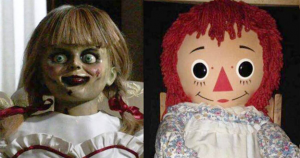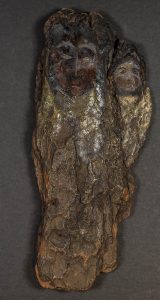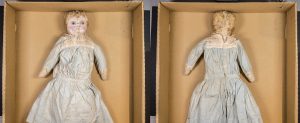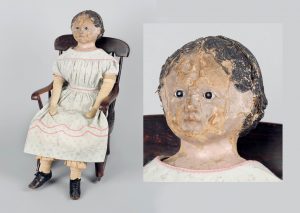By Viv Williams, Processing Assistant and Library Assistant
Hello again, Beehive readers! As I prepared to write this blog, knowing you would see it during peak spooky season, I wondered what other seemingly nonthreatening items in our collection I could relate to a terrifying bit of horror pop culture. If you’ve read the title, you’ll have already tracked my conclusion.
This week we’re moving away from literature and heading straight to the big screen to discuss one of the 2000’s most popular horror movie franchises, The Conjuring. The film series is very loosely based on a famous Ed and Lorraine Warren case involving an “inhuman spirit” that tricks two young women into allowing it to possess a Raggedy Ann doll named Annabelle. Yes, you read that correctly. The adorable red-yarn-headed doll character from Johnny Gruelle’s 1918 book, Raggedy Ann Stories became the culprit of nightmares in 1970 when the doll, gifted to a 28-year-old nursing student by her mother, allegedly began moving on its own and leaving notes for the girl and her roommate. The activity would eventually become hostile, and Ed and Lorraine Warren would be called in to investigate. As terrifying as the story is, this doll will probably be the least threatening-looking doll I mention. In fact, the original Annabelle is so unassuming, the makers of The Conjuring film chose to give her a new look. They were concerned she wouldn’t be scary enough as is.

Now, as far as I know, none of the dolls in the MHS collection are inhabited by otherworldly entities or are guilty of unexplainable animation, but we are often unnerved by them regardless. Which begs us to echo the question from my previous clown blog– When did they become so menacing in the public eye? Linda Rodriguez McRobbie’s Smithsonian Magazine article (which I highly recommend reading) argues that dolls set off a paranoia in us because they look human, but simultaneously we know they aren’t. “Our brains are designed to read faces for important information about intentions, emotions and potential threats…However much we know that a doll is (likely) not a threat, seeing a face that looks human but isn’t unsettles our most basic human instincts.” The more realistic dolls have become over time, the more unsettled we find ourselves.
With that in mind, I’m starting with the least life-like doll, and you can decide if its lack of humanoid features makes it more or less creepy.

This “Painted Bark Doll” would have belonged to a Native American child but was donated to the MHS from the study of American historian Francis Parkman. It’s unclear how Parkman came into possession of the doll, but we do know he spent some time living with a Sioux tribe in the 1840s, so perhaps he acquired it then. The painted piece of bark seems to depict a mother carrying a child, and I think that makes the doll rather endearing. However, upon sharing an image of this doll with a friend sans context, he still found the faces to be unnerving, responding simply, “That’s horrifying.”
John Leonetti, director of Annabelle, argues that dolls are the perfect vehicle for horror because they emulate human features, but lack emotion. It’s this inability to decipher the humanoid face that scares us and becomes a perfect empty slate for something more sinister.
This next doll from [1910] named “Mama” belonged to Hilda Pfeiffer, daughter of Rachael and George Pfeiffer whose papers can be found in the Hartwell-Clark family papers. Rachael Pfeiffer passed away in childbirth to Hilda which is likely the reasoning behind the doll’s unusual name. That connection alone is enough to unsettle me, personally. The doll is made from fabric and canvas and stuffed with cotton. Parts of her oil-painted face are missing, and the back of her head is completely bare. I wonder if these imperfections bring you more comfort or alarm?

I close this blog with one of the MHS’s most well-known dolls, Rebeccah Codman Butterfield. None of the previous dolls can hold a candle to the features of this doll our Object of the Month post refers to as “charming.” I find this doll to have the most in common with the Hollywood Annabelle in terms of spook factor (that’s a technical term), and after a verbal survey of a few friends and coworkers, we unanimously found this doll to be downright creepy.

Take a moment to stare into those perfect brown glass eyes pressed in the aged papier mache face and tell me, honestly, that you don’t feel the least bit unsure of yourself. She is the most life-like of all the dolls and by far the tallest at 81 cm in height. That’s about half as tall as Danny DeVito… Imagine waking up to a doll of that stature standing next to you. No, thank you. And to top it, she arrived with her own note written in first person. Did I mention that Annabelle left the girls notes?
I can feel your shoulders tensing through the screen. Relax, I’m just teasing. The note was written by Ellis Phinney Taylor, her previous owner and it details as much of the history of the doll as we know. If you’d like to learn more about Rebecca and where she hails from, be sure to check out her Object of the Month page.
If you’re a glutton for punishment, or you just really like dolls, we have more! Check our online catalog, ABIGAIL, or consider using the Library’s virtual reference services!

